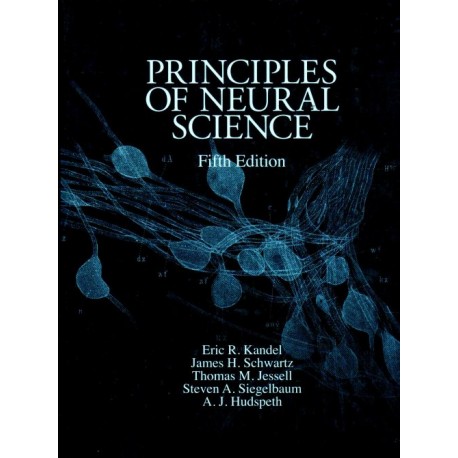Sin productos
Precios están sin IVA
Producto añadido correctamente a su carrito de compras
Hay 0 artículos en su carrito. Hay 1 artículo en su carrito.
¡Producto agregado con éxito a la cotización!
Atención a clientes Whatsapp
 Ver más grande
Ver más grande
En Existencia
Principles of Neural Science
9780071390118
Autor : Kandel R. Eric
Materia : Neurología
Editorial : McGraw-Hill
Año : 2013
Edición : 5th
Idioma : Inglés
ISBN : 9780071390118
Tamaño : 28cm x 22cm
Paginas : 1706
Encuadernación : Pasta dura
Tipo de Impresión : A color
Más información
PRINCIPLES OF NEURAL SCIENCE
Principles of Neural Science, 5e describes our current understanding of how the nerves, brain, and mind functions. From molecules and cells to anatomic structures and systems to senses and cognitive functions, this comprehensive reference covers every aspect of neuroscience. Market: Neuroscientists (50,000 worldwide), neurologists (18,000 worldwide), psychiatrists (80,000 worldwide), medical students (18, 750 per year) More than 900 full-color illustrations Lead author Eric Kandel was awarded the Nobel Prize in Physiology or Medicine in 2000 Completely updated to reflect the tremendous amount of new research and developments in neuroscience over the past decade
CONTENTS
PART I: Overall Perspective (Kandel, Hudspeth)
1. The Brain and Behavior (Kandel, Hudspeth)
2. Nerve Cells, Neural Circuitry, and Behavior (Kandel, Barres, Hudspeth)
3. Genes and Behavior (Bargmann, Gilliam)
PART II: Cell and Molecular Biology of the Neuron (Siegelbaum, Hudspeth)
4. The Cells of the Nervous System (Schwartz, Barres, Goldman)
5. Ion Channels (Siegelbaum, Koester)
6. Membrane Potential and the Passive Electrical Properties of the Neuron (Siegelbaum, Koester)
7. Propagated Signaling: The Action Potential (Siegelbaum, Koester)
PART III: Overview: Synaptic Transmission (Siegelbaum, Hudspeth)
8. Overview of Synaptic Transmission (Siegelbaum, Kandel)
9Signaling at the Nerve Muscle Synapse: Directly Gated Transmission (Siegelbaum, Kandel)
10. Synaptic Integration in the Central Nervous System (Siegelbaum, Kandel, Yuste)
11. Modulation of Synaptic Transmission: Second Messengers (Clapham, Siegelbaum, Schwartz)
12. Transmitter Release (Siegelbaum, Kandel, Sudhof)
13. Neurotransmitters (Schwartz, Javitch)
14. Diseases of Nerve and the Motor Unit (Brown, Cannon, Rowland)
PART IV: The Neural Basis of Cognition (Hudspeth, Kandel)
15. The Organization of the Central Nervous System (Amaral, Strick)
16. The Functional Organization of Perception and Movement (Amaral)
17. From Nerve Cells to Cognition: The Internal Representations for Space and Action (Kandel)
18. The Organization of Cognition (Olson, Colby)
19. Cognitive Functions of the Premotor System (Rizzolatti, Strick)
20. Functional Imaging of Cognition (Small, Heeger)
PART V: Perception (Hudspeth)
21. Sensory Coding (Gardner, Johnson)
22. The Somatosensory System: Receptors and Central Pathways (Gardner, Johnson)
23. Touch (Gardner, Johnson)
24. Pain (Basbaum, Jessell)
25. The Constructive Nature of Visual Processing (Gilbert)
26. Low-Level Visual Processing: The Retina (Meister, Tessier-Lavigne)
27. Intermediate-Level Visual Processing: Visual Primitives (Gilbert)
28. High-Level Visual Processing: Cognitive Influences (Albright)
29. Visual Processing and Action (Wurtz, Goldberg)
30. The Inner Ear (Hudspeth)
31. The Auditory Central Nervous System (Oertel, Doupe)
32. Smell and Taste: The Chemical Senses (Buck, Bargmann)
PART VI: Movement (Hudspeth)
33. The Organization and Planning of Movement (Wolpert, Pearson, Ghez)
34. The Motor Unit and Muscle Action (Enoka, Pearson)
35. Spinal Reflexes (Pearson, Gordon)
36. Locomotion (Pearson, Gordon)
37. Voluntary Movement: The Primary Motor Cortex (Kalaska, Rizzolatti)
38. Voluntary Movement: The Parietal and Premotor Cortex (Rizzolatti, Kalaska)
39. The Control of Gaze (Goldberg)
40. The Vestibular System (Goldberg, Hudspeth)
41. Posture (MacPherson, Horack)
42. The Cerebellum (Lisberger, Thach)
43. The Basal Ganglia (Wichmann, DeLong)
44. Genetic Mechanisms in Degenerative Diseases of the Nervous System (Zoghbi)
PART VII: The Unconscious and Conscious Processing of Neural Information (Kandel, Siegelbaum, Schwartz)
45. The Sensory, Motor, and Reflex Functions of the Brain Stem (Saper, Lumsden, Richerson)
46. The Modulatory Functions of the Brain Stem (Richerson, Aston-Jones, Saper)
47. The Autonomic Motor System and the Hypothalamus (Horn, Swanson)
48. Emotions and Feelings (LeDoux, Damasio)
49. Homeostasis, Motivation, and Addictive States (Shizgal, Hyman)
50. Seizures and Epilepsy (Westbrook)
51. Sleep and Dreaming (McCormick, Westbrook)
PART VIII: Development and the Emergence of Behavior (Jessell)
52. Patterning the Nervous System (Jessell, Sanes)
53. Differentiation and Survival of Nerve Cells (Jessell, Sanes)
54. The Growth and Guidance of Axons (Sanes, Jessell)
55. Formation and Elimination of Synapses (Sanes, Jessell)
56. Experience and the Refinement of Synaptic Connections (Jessell, Sanes)
57. Repairing the Damaged Brain (Sanes, Jessell)
58. Sexual Differentiation of the Nervous System (Shah, Jessell, Sanes)
59. The Aging Brain (Jessell, Sanes)
PART IX: Language, Thought, Affect, and Learning (Kandel, Schwartz)
60. Language (Kuhl, Damasio)
61. Disorders of Conscious and Unconscious Mental Processes (C. Frith)
62. Disorders of Thought and Volition: Schizophrenia (Hyman, Cohen)
63. Disorders of Mood and Anxiety (Hyman, Cohen)
64. Autism and Other Neurodevelopmental Disorders Affecting Cognition (U. Frith, Happe, Amaral, and Warren)
65. Learning and Memory (Schacter, Wagner)
66. Cellular Mechanisms of Implicit Memory Storage and the Biological Basis of Individuality (Kandel, Siegelbaum)
67. Prefrontal Cortex, Hippocampus, and the Biology of Explicit Memory Storage)
Appendices
A. Review of Basic Circuit Theory (Koester)
B. The Neurological Examination of the Patient (Kriegstein, Brust)
C. Circulation of the Brain (Brust)
D. The Blood-Brain Barrier, Choroid Plexus, and Cerebrospinal Fluid (Laterra, Goldstein)
E. Neural Networks (Seung, Yuste)
F. Theoretical Approaches to Neuroscience: Examples From Single Neurons to Networks (Abbott, Fusi, Miller)
ABOUT THE AUTHOR
University Professor, Department of Neuroscience Professor and Director, Kavli Instituto for Brian Science

